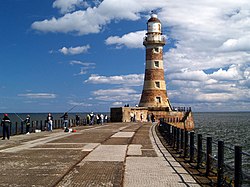Roker Pier Lighthouse
| Roker Pier Lighthouse | |

| |
|---|---|
| Location | |
| Grid reference: | NZ41605870 |
| Location: | 54°55’17"N, 1°21’9"W |
| Characteristics | |
| Height: | 75 feet |
| Tower shape: | tapered cylindrical tower with balcony and lantern |
| Tower marking: | White and red band tower, white lantern room, black lantern roof |
| Light: | Fl W 20s. |
| Focal height: | 82 feet |
| Range: | 23 nautical miles |
| History | |
| Built 1903 | |
| Information | |
Roker Pier Lighthouse stands at the pier-head at Roker in County Durham.
The light was completed in 1903. Its distinctive stripes are of naturally coloured red and white Aberdeen granite. When built it was said to be Britain's most powerful port lighthouse. Equipped with a third-order rotating catadioptric optic (consisting of a single-panel Fresnel lens backed by a prismatic mirror), it displayed a single flash every five seconds. The lighthouse had initially (like its predecessors) been lit by gas from the town mains, but the supply to the end of the pier was found to be intermittent so the gas light was soon replaced by a Chance Brothers incandescent petroleum vapour mantle lamp.[1] This increased the effective intensity of the light from 40,000 to 150,000 candle power, to give it a range of 15 nautical miles.
A fog siren was also provided, powered by compressed air from a pair of 7-horsepower gas engines located in the basement. It gave a two-second blast every twenty seconds in foggy weather from a sounder on the parapet, which was regulated by clockwork.[1]
The light was semi-automated in 1936 when a new light system was installed by AGA.[2] The main lamp was a 750-watt incandescent light bulb, with a gas mantle lamp (fed from the town supply) provided as a stand-by, activated by an automatic lamp changer; and a small electric motor automatically wound the clockwork which rotated the lens.[3]
Full automation followed in 1972, when the old optic was replaced by two back-to-back arrays of six sealed beam units mounted on an AGA gearless rotating pedestal, to give the light an increased range of 23 nautical miles; a new fog horn was also provided at the same time.[2] The system was supervised remotely from the Pilot House on the Old North Pier. Subsequent to its removal the 1903 optic was added to the maritime collection of Sunderland Museum and Art Gallery.[4]
In 2007 the lighting system was again replaced with a dual-drive Pelangi PRL400 rotating pedestal and lamp.[5]
Roker Pier Lighthouse still functions today. Both pier and lighthouse have undergone significant refurbishment in recent years.[6]
In 2012, as part of the restoration, a new flashing LED lamp array was installed, replacing the small Pelangi unit previously in use.[5] In 2018, following a comprehensive six-year process of refurbishment, the lighthouse was opened to the public for the first time; regular guided tours now take place, with access provided by way of the tunnel which runs the length of the pier.[7]
Outside links
| ("Wikimedia Commons" has material about Roker Pier Lighthouse) |
References
- ↑ 1.0 1.1 Fowler, A. F. (1905). "The Evolution of Harbour Engineering". Transactions of the Liverpool Engineering Society 26: 235–246.
- ↑ 2.0 2.1 "People, Ports and Places". The Dock and Harbour Authority 57 (672): 271. November 1976.
- ↑ Shears, William Sydney (1952). Travel and invention in the modern world. London: Virtue & Co.. p. 206.
- ↑ Heal, Veryan (1988). Britain's Maritime Heritage. Conway Maritime Press. p. 117.
- ↑ 5.0 5.1 Jones, Robin (2014). Lighthouses of the North East Coast. Wellington, Somerset: Halsgrove. pp. 74–81. ISBN 978-0-85704-234-7.
- ↑ "Northern Archaeological Associates". http://northernarchaeologicalassociates.co.uk/profile/44-RP.htm.
- ↑ "Welcome to Roker Pier". https://www.rokerpier.co.uk/.
